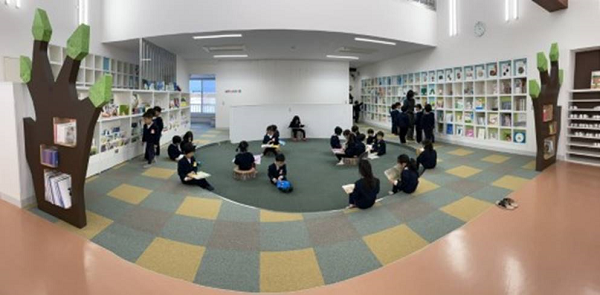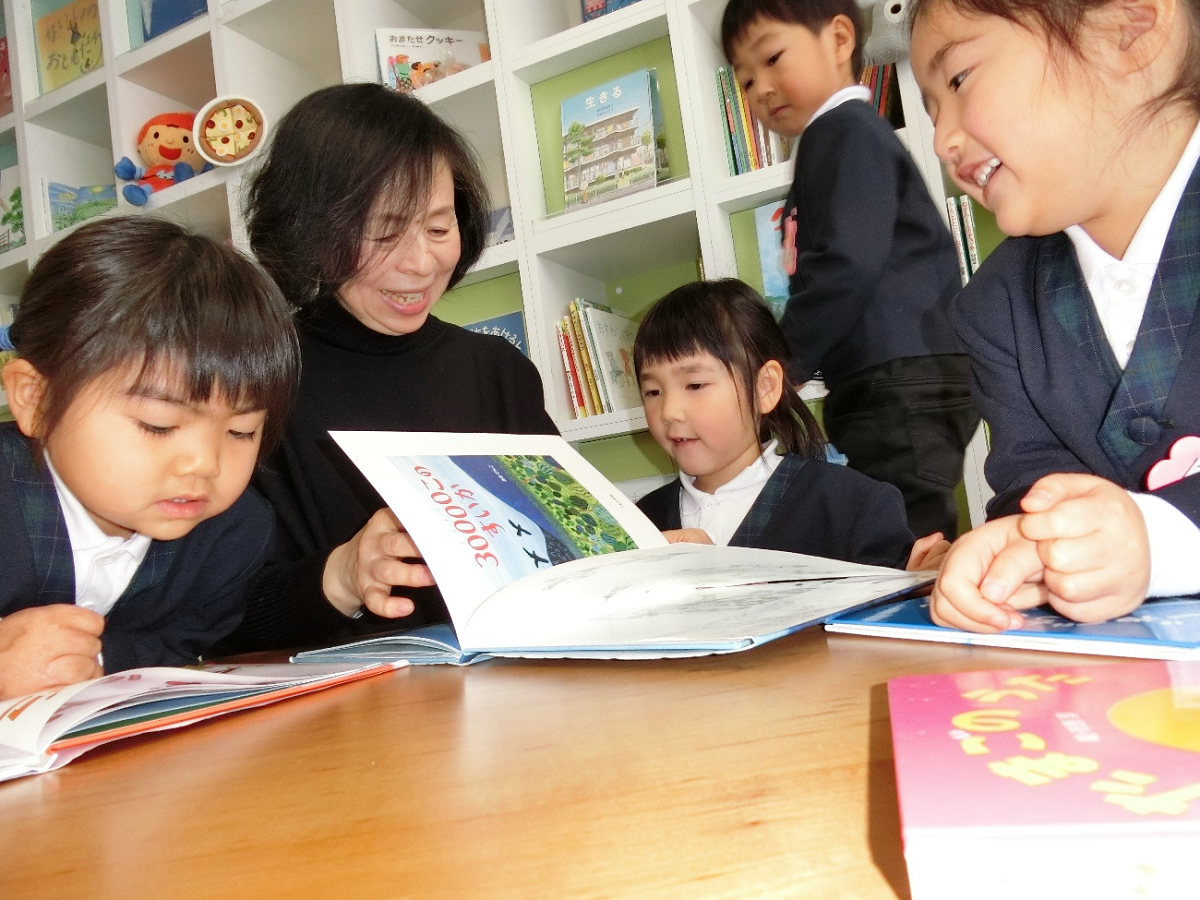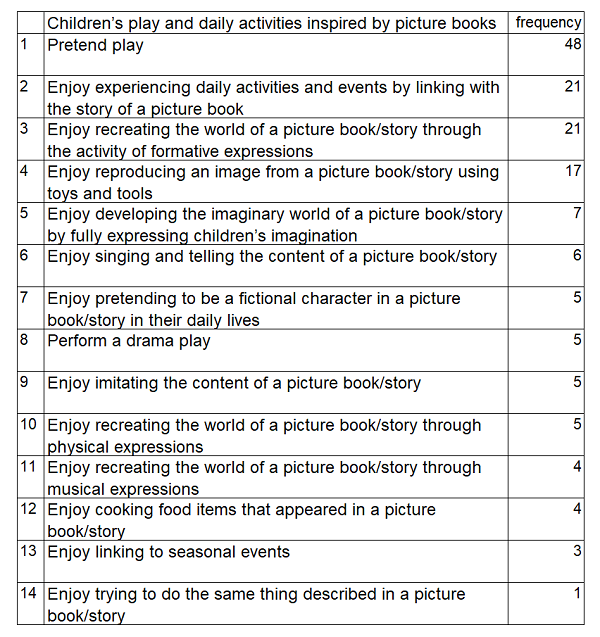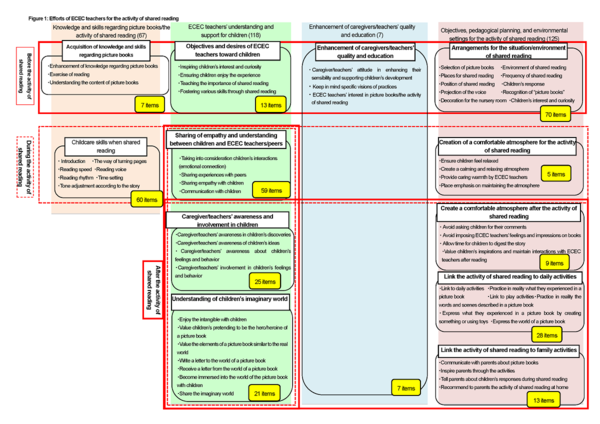Nowadays, picture books and other storybooks are familiar to children, parents, and caregivers/teachers to such an extent that they seem indispensable for childrearing environments. Accordingly, I have conducted a research survey on the activity of shared reading, mainly in ECEC settings, focusing on its effects on children's development and the role of ECEC teachers in helping children with the activity. In this report, some of the results from my survey will be introduced, including the actual conditions of such activities in ECEC settings.
1. About the activity of "shared reading"
When children read picture books and other storybooks with adults, we usually describe it as "reading aloud to children." I have reviewed 21 recent pieces of literature that discuss the activity of reading picture books and other story books, aiming to understand social perceptions towards the activity of reading aloud to children (Nakamoto, 2015). As a result, it was confirmed that the significance of the activity includes the following nine elements:
- 1. Shared reading
- 2. Sharing the story of a picture book, feelings, affections, interactions, activities, and atmospheres
- 3. Sharing pleasure and enjoyment
- 4. Encouraging children's voluntary (proactive) behavior in reading
- 5. Building and deepening interpersonal relationships
- 6. Enhancing communications and physical contacts
- 7. Inspiring children's interest in letters and words
- 8. Fostering children's sensibility and inquiring mind
- 9. Developing play activities inspired by picture books during or after reading
I also visited some childcare facilities and observed the activity of reading picture books. Consequently, I found out that, in many cases, the activity creates mutual interactions between ECEC teachers and children, as well as interactions among children. Furthermore, the activity of reading often extended to other activities after reading (Nakamoto et al., 2011). Based on the above survey results, it was revealed that picture books and story books are not just being "read aloud" as a one-way act of adults to children, but delivering a reciprocal action of "shared reading." Therefore, I defined it as the activity of "shared reading" and summarized its characteristics into the following four categories:
(1) Exchange words, feelings, expressions, and behaviors when children are reading picture books together with adults or peers |
2. The role of ECEC facilities in inspiring children to explore the world of picture books and story books
(1) The role of ECEC teachers in the activity of shared reading in ECEC settings
I conducted a paper-based questionnaire survey targeting 238 ECEC teachers who practice the activity of shared reading in their daily tasks (Nakamoto et al., 2013). First, the survey asked open-ended questions such as "How do you conduct the activity of shared reading in your daily childcare tasks? What do you pay special attention to when conducting the activity of shared reading?" Then, I analyzed the results using the KJ Method, a brainstorming-based technique, with two childcare workers and three teachers specialized in childcare.(Note 1) Finally, the words and phrases used in their answers were classified into the following twelve items:
- 1. Acquisition of knowledge and skills about picture books
- 2. Childcare skills for shared reading
- 3. Objectives and desires of ECEC teachers toward children
- 4. Sharing of empathy between children and ECEC teachers/peers
- 5. Awareness and attitudes of ECEC teachers toward children
- 6. Understanding of children's imaginary world
- 7. Enhancement of ECEC teachers' quality and literacy
- 8. Arranging for the situation/environment of shared reading
- 9. Creation of atmosphere during the activity of shared reading
- 10. Linking the activity of "shared reading" to daily activities
- 11. Creation of atmosphere after the activity of shared reading
- 12. Linking the activity of "shared reading" to family activities
Next, we further classified these twelve items into the following four groups.
- (A) Knowledge and skills about picture books/the activity of shared reading
- (B) ECEC teachers' understanding and support for children
- (C) Enhancement of ECEC teachers' capabilities and literacy
- (D) Objectives, childcare planning, and environmental settings for the activity of shared reading
Finally, they were categorized into three groups of "before, during, and after" shared reading. The figure shown below summarizes the classification results.
As you can see from the above figure, ECEC teachers try to acquire knowledge and skills about picture books and the activity of shared reading before reading. They also make efforts to enhance their quality and educational skill as ECEC teachers on a routine basis. Based on their knowledge and skills acquired through such efforts, they create a childcare plan for shared reading, reflecting their objectives and desires toward children as well as the conditions and environment of the activity.
ECEC teachers value the activity of shared reading, which leads to sharing feelings and thoughts between children and teachers or peers. In addition, teachers recognize children's discoveries, ideas, feelings, and behavior and through the activity of shared reading which deepens their understanding of the children's imagination and impressions. Furthermore, they prepare childcare plans and set up the environment to create an atmosphere after shared reading, linking the outcome to daily activities. Finally, they talk with parents about children's responses to picture books and the activity of shared reading, thereby encouraging parents to carry out this activity at home.
It is confirmed that ECEC teachers utilize the activity of shared reading in their daily childcare tasks to support children's development. More precisely, they observe children's feelings and behavior during the activity. Based on such observations, they try to have mutual interactions by talking, encouraging, and helping children with verbal expressions pertinent to the situation. In addition to support for children's development, teachers also prepare childcare plans and environmental settings to link the activity of shared reading to children's daily and family lives.
As for the number of items in each category answered by ECEC teachers, it is confirmed that they give particular consideration to the items of "Understanding and support for children (118 items)" and "Objectives, childcare planning, and environmental setting for shared reading (125 items) in their activity of shared reading. In particular, the result of "Understanding and support for children" suggests that teachers try to understand and support children's endogenous abilities through the activity of shared reading.
The above results show that ECEC teachers have objectives and desires to understand children's interests, curiosity, discoveries, ideas, feelings, and imagination that arise from the activity of shared reading. Then, they help children develop activities based on such interests and feelings. In addition, as the result of "Enhancement of ECEC teachers' quality and education" shows, caregivers/teachers also make efforts to enhance their capabilities in endogenous aspects, thereby providing more supportive environments for children. Moreover, ECEC teachers give further consideration to the environmental aspects of shared reading. For example, they try to create a calm and relaxing atmosphere for reading, have dialogue after reading, observe and understand children's resonance and feelings, and help children express their emotions inspired by reading. Finally, ECEC teachers tell parents about children's responses and activities during and after reading.
To sum up, it is apparent that childcare providers fully understand children's emotional movements in endogenous aspects while conducting the activity of shared reading, and make various efforts to support children's development.
(2) Case study: children enjoy reading picture books with a picture book specialist
In addition to the survey on the efforts of ECEC teachers, a field survey was also conducted to assess the significance of human/physical environments that familiarize children with reading. In this report, one of the case studies will be introduced: Hachinohe Bunka Kindergarten, a kindergarten-daycare-integrated ECEC center (nintei kodomo-en) in Aomori Prefecture.
Hachinohe Bunka Kindergarten has a "Picture Book House" (Photo 1) with about 1,300 books. Children can freely pick up a book and enjoy reading it. Like public libraries, the Picture Book House grants young children the right to choose and read picture books and other stories independently. Furthermore, a picture book specialist serves there on a full-time basis, helping each child to choose and enjoy reading books (Photo 2).(Note 2) In this way, the kindergarten assists children in discovering attractive picture books and other stories according to their needs, which can deepen their enjoyment of reading. In addition, a picture book specialist gives advice to parents on how to choose picture books for their children and the value of sharing the enjoyment of reading with them. She also responds to inquiries from parents, thereby playing an essential role in support of their childrearing.
This case study shows that, besides teachers' efforts, the creation of various human/physical environments also enriches the constructive activity of "shared reading."


3. Children's play inspired by picture books
I conducted a paper-based questionnaire survey targeting 170 ECEC teachers about children's play activities inspired by picture books in ECEC settings. I asked open-ended questions and analyzed the episode descriptions of 85 respondents (Nakamoto, 2018).
The results show the frequency of each play activity inspired by picture books in the respondents' descriptions as follows:
| 48 times | : | Pretend play |
| 21 times | : | Enjoy experiencing daily activities and events by linking with the story of a picture book Enjoy recreating the world of a picture book/story through the activity of formative expressions |
| 17 times | : | Enjoy reproducing the image of a picture book/story using toys and tools |
| 7 times | : | Enjoy developing the imaginary world of a picture book/story by fully expressing children's imagination |
| 6 times | : | Enjoy singing and telling the story of a picture book |
| 5 times | : | Enjoy pretending to be a fictional character in a picture book/story in children's daily lives Perform in a drama play Enjoy imitating the story of a picture book |
| 4 times | : | Enjoy recreating the world of a picture book/story through musical expressions Enjoy cooking food items that appeared in a picture book/story |
| 3 times | : | Enjoy linking to seasonal events |
| 1 time | : | Enjoy trying to do the same thing described in a picture book/story |
The results of this survey confirmed that reading picture books nurtures children's imaginative and creative abilities, inspiring various play activities.
Table: Children's play and daily activities inspired by picture books

4. To develop children's imaginative/creative abilities = intangible abilities
Today, the provision of reading environments where children can choose, read, and enjoy picture books and other story books is regarded as a fundamental right of children (ILA, 2018).
Each person experiences feelings, thoughts, and responses to various cultural elements in their own way. Therefore, children's responses vary in reading picture books and playing activities inspired by reading. This difference indicates that each child's imaginative and creative abilities (= invisible abilities) are nurtured by shared reading. Like the "Right to Read" mentioned above, nurturing such abilities is also one of the children's valuable rights. Therefore, we adults, including ECEC teachers, should provide effective human environments where development of children's imaginative and creative abilities (invisible abilities) is carefully observed, recognized, and understood. It is also crucial for us to be active co-workers in children's play and to link their learning to further enriching expressions.
I published a book with the practitioners of "shared reading" titled "Children's world of play inspired by picture books: the activity of reading picture books together" (Higuchi & Nakamoto, 2017). The book summarizes ECEC teachers' childcare practices by reading picture books with children. I hope our readers will find it helpful to understand children's imaginative and creative abilities (intangible abilities) nurtured through the activity of shared reading.
Notes:
- Note 1: The KJ method is a technique for analyzing data developed by Professor Emeritus Jiro Kawakita at the Tokyo Institute of Technology. This method records data on a card label, and sentences and phrases are grouped. By repeating this process, the entire body of data is organized and analyzed.
- Note 2: A picture book specialist is a person with a high level of knowledge, skills, and literacy for picture books. This qualification was introduced in 2012 and will be given to those who completed a training course specializing in picture books and received a good rating for necessary skills and capabilities.
References
- • Mio Nakamoto, Megumi Kurihara, Kazuya Siraishi, Masaharu Higuchi, and Naoki Uno. (2011). Linking the activity of shared reading with childcare I: from the perspective of children's independent and active attitudes. The Collection of Academic Papers in the 64th Conference by the Japan Society of Research on Early Childhood Care and Education.
- • Mio Nakamoto. (2013). Childcare methodology through the activity of reading books together in ECEC settings. The Collection of Academic Papers in the 66th Conference by the Japan Society of Research on Early Childhood Care and Education.
- • Mio Nakamoto. (2015). Development of training programs for nursery teachers to promote the activity of reading picture books together: aiming to achieve mutual interactions that enhance children's developments. Minerva Shobo.
- • Mio Nakamoto. (2018). A study on children's play inspired by picture books: analysis on the episode descriptions of nursery teachers. The Collection of Academic Papers in the 28th Conference by the Japanese Society for Education of Young Children.
- • Masaharu Higuchi & Mio Nakamoto. (2017). Children's world of play inspired by picture books: the activity of reading picture books together. Fuumeisha.
- • International Literacy Association (ILA) Children's Rights to Read(literacyworldwide.org)
https://www.literacyworldwide.org/docs/default-source/resource-documents/ila-childrens-rights-to-read-Japanese.pdf
















